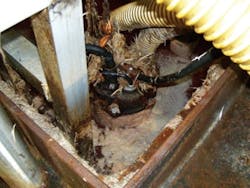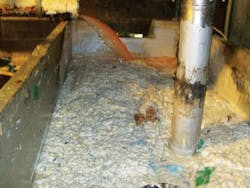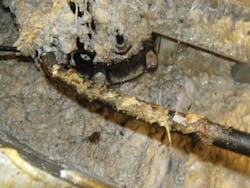About the author: Mike Bjorkman is marketing and IT manager for BJM Pumps. Bjorkman can be reached at 860.399.5937.
With more than 400 facilities worldwide, one of the world’s largest meat processors and marketers produced more than 42 million chickens and 500,000 head of beef and pork per week in 2010.
Messy Machines
Depending on the species, one-third to half of every animal produced for meat in the U.S. is not consumed by humans. At a chicken processing plant, feathers, fat, blood, bone, organs and certain parts such as heads and feet—collectively known as offal—are separated from the edible meat. The meat is packaged and shipped to retail stores and restaurants, while the offal is sent to rendering plants where it is processed into high-protein meals or liquids for use in animal feed or biofuel.
At the industrial level, meat production is highly automated. Machines slaughter the animals, cut and trim the parts, separate meat from offal, package the final product, and carry waste away from the production line. It’s a dirty job, and the machinery, walls, and floors of work areas need to be washed regularly for efficient operation, safety and cleanliness.
At a chicken processing plant in northwest Arkansas, workers using hoses wash down equipment by hand, and the runoff—carrying blood, fat, feathers, and small pieces of meat and bone—flows into a huge catch basin. There the runoff sits until it is pumped into a truck for transport to the world’s largest rendering facility, approximately 20 miles away.
Greater Efficiency
For many years, the plant used air-operated diaphragm (AODD) pumps to empty the offal basins, but these were costing the company too much money, especially electricity expenses. To properly do their job, the AODD pumps required a 150-hp compressor to almost constantly be running at the plant, even on weekends when the production lines were not fully operational.
Arkansas Industrial Machinery Inc. (AIM) of North Little Rock, Ark., which sells handling and treatment systems for air, gas and liquids, saw a chance to save the company money by retiring the compressor, which James Reid, an AIM sales representative, described as “the highest-cost utility in the plant.” On Reid’s recommendation in 2010, the company replaced the AODD pumps with three BJM SK55C submersible shredder pumps with a fourth pump used for backup. They have flow rates similar to those of the AODDs, 71⁄2 hp, and run without a compressor pump.
The shredder pumps leave solids slightly larger than those that have passed through a grinder pump. The pumps can also handle up to 3.5-in. solids at 570 gpm with a maximum 59 ft of head.
Designed to Shred
Engineered to shred solids, the shredder pump utilizes a cutting impeller with a tungsten carbide tip to continuously rip apart solids against a tooth-edged, spiral-shaped diffuser plate. With 360-degree shredding action and non-clog, single-vane impellers, the pumps can shred bone and other tough offal at the processing plant. The hardened cast iron helps the pumps withstand the rough work, and a stainless steel motor housing offers abrasion resistance.
Detect and Respond
The pumps also come with a moisture detection system to provide additional protection that helps the staff avoid emergencies. The sensor probe inside the oil chamber can provide an early warning to protect the pump motor, and when the seal failure circuit or moisture detection circuit is properly connected to a control panel, it informs the pump operator that moisture is in the oil chamber. This early warning can allow the operator to schedule repair and inspection on the pump before an injury occurs.
The shredder pump’s motor is protected by double mechanical seals. The lower seal is made of silicon carbide, and the upper seal is made of carbon and ceramic. An additional lip seal above the impeller helps prevent abrasives such as dirt, silt or sand from entering into the seal chamber.
Additionally, the winding protection and NEMA Class F motor insulation allows the motor temperature to rise to 230°F. An automatic switch turns the pump motor off if the temperature or amp draw gets too hot. When the motor cools, the switch will automatically reset and the pump will turn back on.
“There’s enough torque in the SKs to keep them from plugging up,” Reid said. “If they hit a bone, they just shear it.”
The pumps have run nearly 12 hours per day since their installation with no unexpected failures, leading the company to use them for other applications and to designate the submersible shredder pumps as the plant’s standard equipment.



